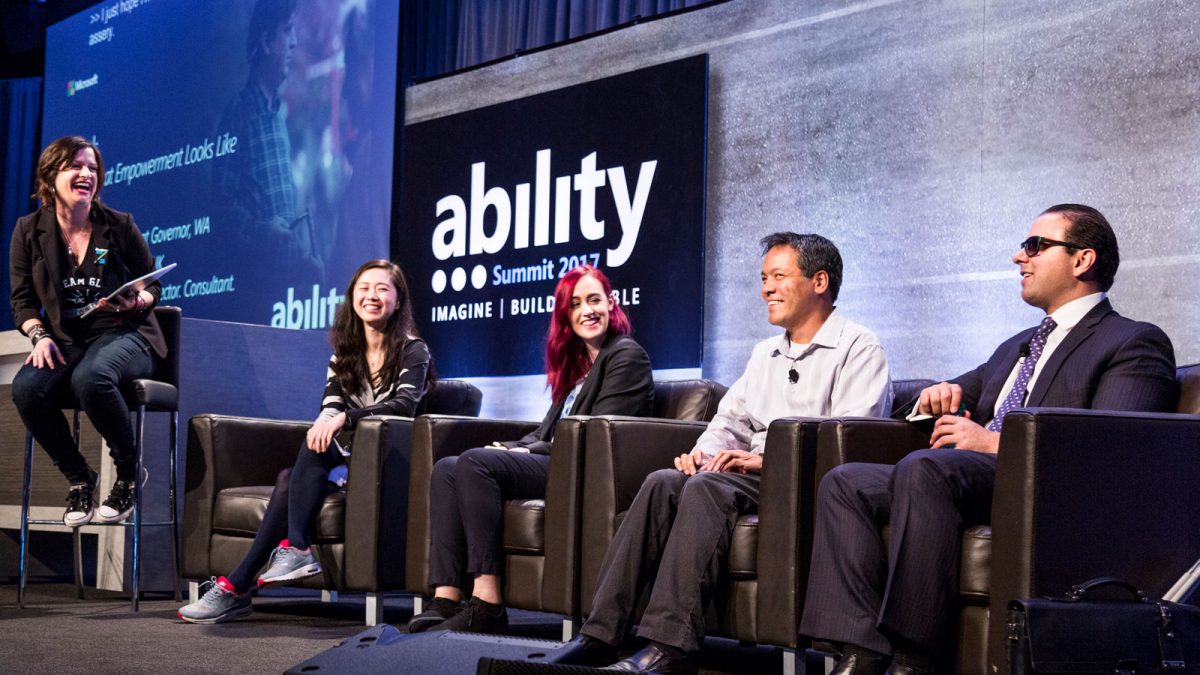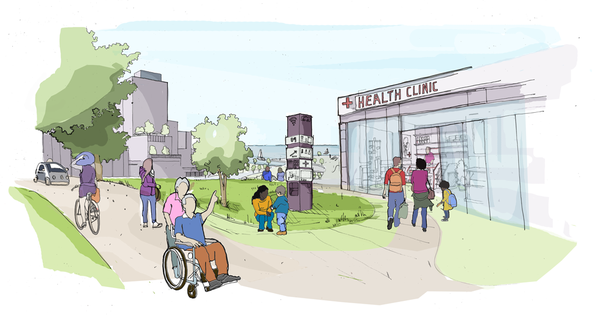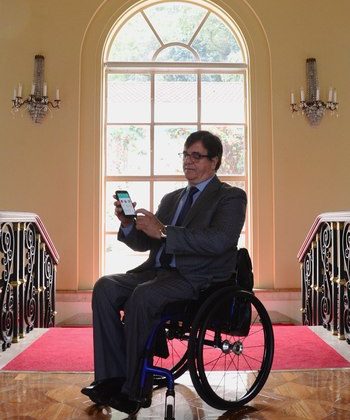Empowering a more accessible and inclusive world
May 18, 2017 | Jenny Lay-Flurrie – Chief Accessibility Officer
With the right tools, there are no limits to what people can achieve, including people with disabilities. So today has special meaning: It’s the sixth Global Accessibility Awareness Day focused on raising awareness of digital accessibility to build a more accessible and inclusive world, and a great day to reflect on the journey both past, present and future.
As many of you know, our mission at Microsoft is to empower every person and every organization on the planet to achieve more. Technology can play a tremendous role in each of our journeys to reach our goals. Recently, we’ve had a lot of fun sharing some of the ways we are committed to accessibility and inclusion. Last week at Microsoft Build, Harry Shum, executive vice president of Artificial Intelligence & Research, shared technology that is already having an impact on my life: Real-time captioning in PowerPoint, which is currently in preview and leverages an add-in powered by Microsoft Translator live. This translates speech into one of 10 languages, but also provides speech-to-text with an incredible level of accuracy for folks like me with deafness. Can’t wait for you to try it. In addition, Terry Myerson, executive vice president of the Windows and Devices Group, demoed Narrator developer mode during his Windows keynote, and CEO Satya Nadella closed his keynote with details of new research into technology for people with Parkinson’s called Project Emma. If you haven’t watched the video, please stop what you’re doing and check it out (have tissues nearby).
Sharing stories like Emma’s of how technology can help transform lives inspires us all. It helps to drive awareness and highlight the momentum that accessibility has right now in the world. At Microsoft, it drives us to invest more because accessibility is one of the clear paths to empowerment. Today, I want to share some of the latest and greatest things happening in schools, workplaces and the world of technology, and also some new training and awareness materials we’re launching today. There is a lot to talk about! Let’s get into it.
Empowerment in schools and the workplace
Yesterday I spent the morning with a great group of students with disabilities who are in the USBLN mentor program, getting ready to graduate and looking at employment. It was a reminder that how we help prepare students for their journey in this world will set the stage for all that they can achieve. Achievement begins with access, and to help educators ensure students with disabilities have equal access to information in classrooms, we are today launching a new Microsoft Educator Community course on creating accessible classroom content. This training series is brought to you by Microsoft Innovative Educators who work in Special Education, and over the course of 10 short videos, guides you on how to ensure your classroom is inclusive for everyone. Simple steps, but each of them matters.
Content matters. So does technology. I love the stories those in special education share with us about what students around the world are achieving with free, inclusively designed technologies such as Learning Tools Immersive Reader, OneNote and Office Lens. Learning Tools, introduced in OneNote and now built into Word, is helping students with dyslexia learn to read in new ways. The kids in the video are so authentic in showing how using the reader has impacted them, from reading rates to understanding what success feels like. Much of the success has been via OneNote, which is a powerful collaboration tool that meets the needs of the modern teacher and student. Aligned with our core value of inclusiveness, we redesigned OneNote to bring consistency, accessibility and ease-of-use across all platforms to empower every student. The new redesign for OneNote is rolling out for Windows 10, Mac, iOS, Android and on the web over the coming weeks.
With Windows, we continue to deliver accessibility features that enable you to do more. The Windows 10 Creators Update continued the journey of accessibility improvements across the spectrum of disability. For people with visual impairment and blindness, we enabled the installation of Windows without sighted assistance, delivered improvements to Narrator and launched the ability to use braille devices with Windows. For the deaf and hard of hearing, mono audio launched to send sounds across left and right ears, and for everyone, improvements to Microsoft Edge including Read Aloud and text spacing make it easier for everyone to read and enjoy text, including people with learning disabilities such as dyslexia and emerging readers, as well as English Language Learners. The goal is to make Windows the operating system people love for working, learning and playing.
Later this year, new features are coming that will benefit people who are blind or have low vision, and people with reading- and writing-related disabilities. We have published those today in a new blog from the Windows team and strongly suggest checking it out. It shows our ongoing commitment to first- and third-party experiences, and I’m so excited about automatic alternative text and color filters, as well as additional Learning Tools in Edge!
We also recently announced Windows 10 S, which promises devices with faster boot times and improved security and reliability. We believe Windows 10 S is great for many customers; however, if you are using third-party assistive technology apps not currently available in the Windows Store, we will be offering a switch to Windows 10 Pro at no additional charge. More details on that when Windows 10 S becomes available.
Lastly, I do want to make sure that our customers saw the announcement from GW Micro that sales of the Window-Eyes screen reader have ended in the United States and Canada. GW Micro will honor existing product purchases and software maintenance agreements and will continue to provide technical support to end users, and it is offering JAWS for Windows as a replacement. Independent of this, we will also be ending the current Window-Eyes screen reader license offer at the end of June, although GW Micro will continue to allow the download of Window-Eyes for free on its own.
Planning the future with smart cities for all
In addition to helping students and professionals, we recognize that civic leaders and the populations they serve have growing needs for resources that are more inclusive. It’s a hot topic in every city I visit. We’ve invested in technologies that can help create inclusiveness between governments and citizens, and in collaboration with G3ict and World Enabled, we recently launched the Smart Cities for All Toolkit. The mission of the Smart Cities for All initiative is to define the state of accessible technology in cities worldwide with a focus on closing the digital divide for people with disabilities and older people. Based on the initiative’s research and insights from a survey of experts around the world, most of today’s Smart Cities are not fully accessible.
The toolkit aims to empower city leaders with resources that will lead to communities that are more inclusive. Resources include guides for implementing ICT accessibility standards and procurement policies, ideas for how to make the case for a stronger commitment to digital inclusion, and a framework for a database of accessibility solutions. It’s a great start in moving the bar of inclusion in cities.
Driving inclusion in the workplace
Now let’s talk people. Disability is a strength. Having people with disabilities as part of your organization empowers the group, team and company to build products and services that reflect the diverse needs of our global customers. So we are focused on hiring, but also building an inclusive culture, which we believe is at the core of building a long-term successful organization.
We recently sponsored the Autism @ Work Summit, bringing together industry experts with businesses looking to start inclusive hiring programs and together look for ways to help more candidates break through traditional barriers to gain competitive employment. This year, Microsoft hosted the first Autism @ Work virtual career fair, providing candidates with autism a unique online experience to meet with recruiters at companies that are looking for talent. Several employers had virtual job booths staffed by online recruiters, including AT&T, EY, Ford, HPE Dandelion, JP Morgan Chase, Microsoft, NCR and SAP. What we are learning from these events is there is still a lot to do when it comes to disability inclusion and accessibility, but working together will accelerate all of our efforts to find talent.
One of the crucial elements to our broad inclusion programs has been building awareness both internally and externally. We’ve worked (and continue to work!) to update our new Microsoft Accessibility homepage and share additional resources to our global customers. Last year, the entire Microsoft workforce (over 100,000 folks!) received training that aimed to reinforce Microsoft’s commitment to accessibility and inclusion. We then developed additional resources for employees to learn more about the various topics that surround disability inclusion and accessibility. Today we are releasing an Introduction to Disability and Accessibility that includes segments from some of our internal training collateral. Grab a cuppa tea and watch! It’s made a difference at Microsoft, and I know it can raise awareness for these important topics at your organization, too.
We want your feedback
If you are reading this and want to get involved, know we NEED your feedback! Feedback is an incredible gift and crucial if we are to really grasp the opportunity to improve the accessibility and usability of our products and services. There are so many ways you can give feedback to us, including the Microsoft Accessibility UserVoice forum. However, the one I want to highlight today is our Most Valuable Professional (MVP) Accessibility Award category, which we have relaunched.
The Microsoft MVP Award is a unique opportunity to join an elite group of accessibility technology experts who make outstanding contributions to their communities. MVPs will have the opportunity to gain early access to new technology, actively help shape the accessibility of Microsoft technologies and join us in Redmond, Washington, for the MVP Global Summit. It’s a chance to really talk to the people behind the products and services I talk about above!
While there is no single way to become an MVP, we are looking for individuals with a deep knowledge of Microsoft products and who demonstrate accessibility expertise, leadership and the desire to help accelerate learning through social media posting, podcasts, meetups and/or giving presentations (just to name a few). If this sounds like you or someone you know, nominate them today.
It takes all of us to get this right
Lastly, my favorite event of the year at Microsoft: Every year for the last seven years, we have hosted an internal event, the Ability Summit, that brings together our employees from across the company to discuss all things related to accessibility and disability inclusion.
To help foster ideas during this event, employees attend sessions across three tracks — Imagine, Build and Enable — and we bring in leaders from across the company to present on projects that align to those themes. Sessions this year included how to leverage Inclusive Design principles, what global policies our teams need to be thinking about, disability disclosure in the workplace and bug bashes (we’re still nerds at heart). We also present Ability Awards for employees who have had the biggest impact this year — and with the amount of passion in this space, it is a brutal job having to pick just a few employees from the multitude of nominations we receive. We also bring in guest speakers from outside the company to help underscore the opportunity that exists within the tech industry to be agents for change. This year we had the pleasure of hosting Jill Houghton, president and CEO of USBLN, and the lieutenant governor of Washington State, Cyrus Habib, and had packed rooms and record attendance. There was no shortage of demands and challenges for our employees to keep moving forward on accessibility and the passion was and is palpable.
I hope that one or many of these snippets help you grow, drive or build awareness on today, Global Accessibility Awareness Day. I’m excited about the progress and the work we still have ahead of us. Raising awareness about accessibility and disability inclusion is key to the enduring values that our company holds. Building great products that encourage you to bring your best into your classroom, your workplace, your city and your social world is where we’ll be focused until a more accessible and inclusive world is fully realized.
Content retrieved from: https://blogs.microsoft.com/on-the-issues/2017/05/18/empowering-more-accessible-inclusive-world/.
Upcoming Events
There are no upcoming events.




